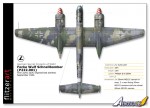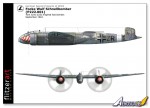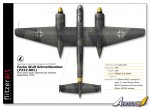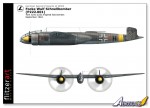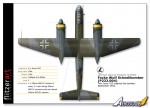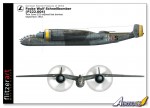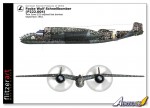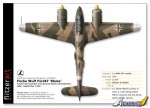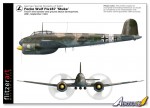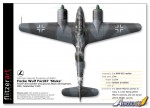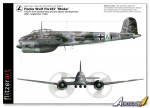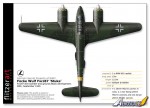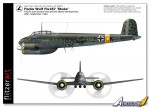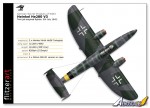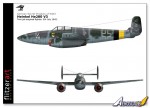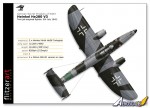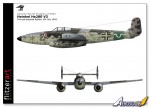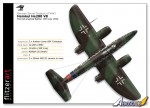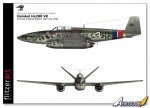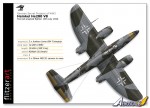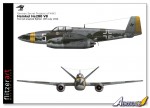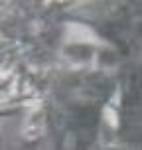1⁄1Luftwaffe Projects - Volume 9
10
Comments
Focke Wulf Fw P222 Schnellbomber
The Focke Wulf Schnellbomber projects, all centered around utilising a pair of the Jumo 222 engines are well known but no drawings were found, until recently that is. Drawings have been found for two of the series, P222.001 and P222.004 both dated September 1942.The P222.001 design is a slim and attractive design featuring large engine nacelles pushed quite far forward to house the Jumo 222s. The tail is of a twin fin type leaving clearance for the maneuverable rear mounted cannon operating room.
The P222.004 design is also slim and attractive design featuring large engine nacelles but this time mounted further back. Design 004 also has a twin fin tail to leave clearance for the maneuverable rear mounted cannon operating room. What is interesting about this design is the inverted ‘W’ main wings or “M’ wing if such a definition exists. Also the fuselage slopes downwards to the front giving low nose and high tail.
To see the original drawings and data sheets please visit: http://www.secretprojects.co.uk/forum/index.php/topic,12184.0.html
Focke Wulf 187 ‘Stuka’
The history of the Fw187 is well documented and it is generally regarded as one of the best WW2 aircraft or at least one of the most promising. Why the RLM ignored it, refusing to put it into full production after splendid prototype results, is a mystery even today. This led to the test aircraft being relegated to the defense of Focke Wulf’s factory for the remainder of the war.However Focke Wulf believed it had a gem of an aircraft and even after it became clear that neither the Fw187A or the more powerful Fw187B were going to enter production, the company continued working on developing further variants, including a Stuka dive-bomber version as depicted here in answer to new RLM specification No. 235.
For the 2 seat Stuka version the original Junkers Ju 601 engines were replaced with a pair of BMW 801s and the fuselage was completely redesigned. Little else remains and there are no official performance figures but the weapons installation is clear.
Heinkel He 280 Twin Jet Fighter
The He280 is well-documented but largely overlooked, being largely eclipsed by the Messerschmitt Me262. However the He280 is, historically, a very important aircraft; it was the first jet combat aircraft, the first twin-jet aircraft and the first jet aircraft to go beyond mock-up stage.In prototype form its trials went very well showing a great deal of potential, leading to a contest flight in 1941 comparing an He 280 with a Fw190. The He 280 completed four laps of an oval course before the Fw 190 could complete three. However the RLM showed little interest awarding production go-ahead to the Messerschmitt 262. This was largely due to the fact that the RLM did not like the He280’s tricycle undercarriage, considering it too frail for grass or compacted earth airfield conditions. The Me 262 initially was a tail sitter, and due to this the angle of the engines’ exhausts, caused a great number of grass fires. Ironically the Me 262’s undercarriage was quickly redesigned and a tricycle arrangement was adopted. In all probability the He280 would have proved to be an excellent aircraft.
Comments
Cheers Peter
My pleasure. It's really impressive to see how your artwork increases steadily in sophistication with each new volume.
I'm intrigued by the mysterious Wn 19 - it does just look like someone's simplistic sketch of a '109, so it'll be really interesting to see if any firm information ever surfaces...
All the best
Rowan
OCT 09, 2012 - 08:08 AM
Many thanks JPTRR, nice to see you are still around site.
Rowan, should I learn of anything more on the Wn 19, I'll definitely share any findings. I'm sure there's a lot more to be discovered.
P
OCT 11, 2012 - 06:55 AM
Great work as always Peter, It's always nice to see a different take on the colour schemes and / or just to see these projects in colour. I do like the little Skoda 257 and the Fw-222.004, and then you tease with the last line 'Italian' for Vol.10, I can't wait, Re.2007 perhaps
OCT 11, 2012 - 07:45 AM
Wonderful stuff, as usual, Pater
Do you have any profiles of aircraft that saw combat during WWII (Spit, 109 etc)?
OCT 11, 2012 - 04:17 PM
Very interesting stuff, I hope to see more in the future.
Thanks for all the effort you put into this.
OCT 15, 2012 - 07:14 AM
Many thanks, I'm just enjoying myself really.
Luciano, Re2007....we'll see .
Mal.
I did do some profiles of some British aircraft that saw actual combat. It was years ago now but they were published on site.
I've not done any more since, apart from some early jets, as there are so many accomplished artists out there that cover these already, I've tended to seek areas that are less well populated if you see what I mean.
Tah muchly
Peter
OCT 19, 2012 - 03:33 AM
"....it was the first jet combat aircraft, the first twin-jet aircraft and the first jet aircraft to go beyond mock-up stage." not so "first" considering and other constructors of jet airplanes before 1941
DEC 26, 2018 - 05:17 AM
Copyright ©2021 by Peter Allen. Images also by copyright holder unless otherwise noted. The views and opinions expressed herein are solely the views and opinions of the authors and/or contributors to this Web site and do not necessarily represent the views and/or opinions of AeroScale, KitMaker Network, or Silver Star Enterrpises. Images also by copyright holder unless otherwise noted. Opinions expressed are those of the author(s) and not necessarily those of AeroScale. All rights reserved. Originally published on: 2012-10-06 00:00:00. Unique Reads: 15547




